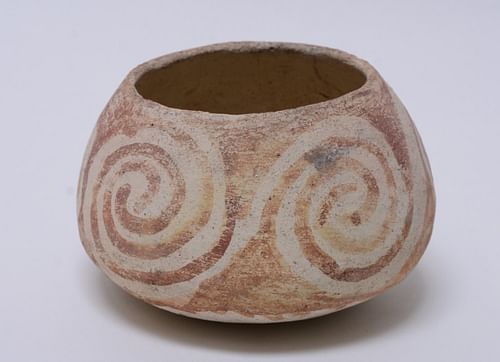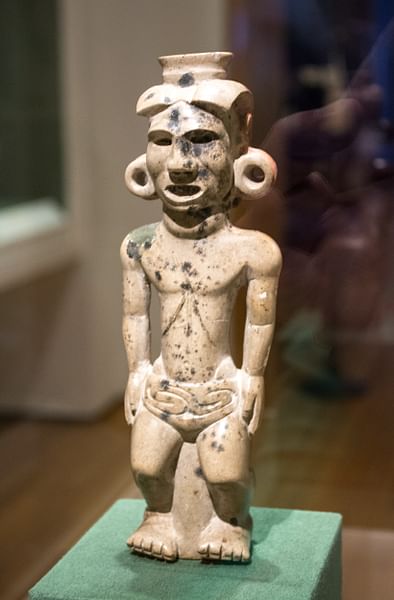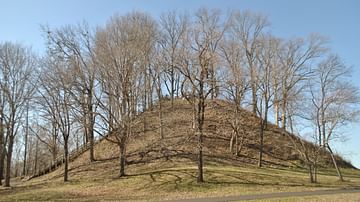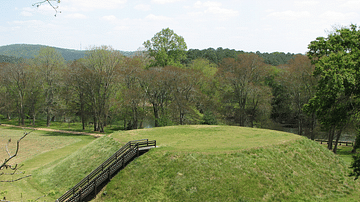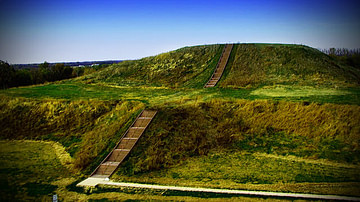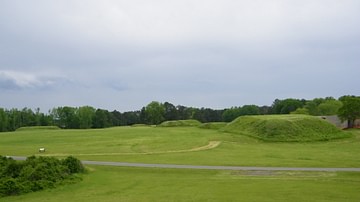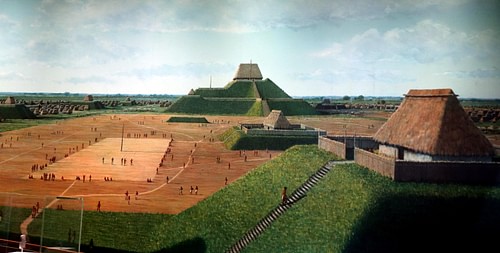
Pre-Colonial North America (also known as Pre-Columbian, Prehistoric, and Precontact) is the period between the migration of the Paleo-Indians to the region between 40,000-14,000 years ago and contact between indigenous tribes and European colonists in the 16th century CE which eradicated the Native American culture, replacing it with what became Canada and the United States of America.
Christopher Columbus (l. 1451-1506) initiated European colonization of the Americas in 1492 when he landed in the West Indies, and this encouraged efforts by the Dutch, French, and, finally, the English to establish colonies in North America beginning in 1534 through 1620 which led to rapid colonization for the next 100 years.
Prior to the arrival of Europeans, the Native Americans lived as autonomous nations (also known as tribes) across the continent from present-day Alaska, across Canada, and throughout the lower 48 United States. In order to study this era more easily, modern-day scholars have divided it into periods:
- Paleoindian-Clovis Culture – c. 40,000 - c. 14,000 BCE
- Dalton-Folsom Culture c. 8500-7900 BCE
- Archaic Period – c. 8000-1000 BCE
- Woodland Period – c. 500 BCE - 1100 CE
- Mississippian Culture – c. 1100-1540 CE
It should be noted that, while efforts have been made to be precise in this dating, the various Native American cultures of the region developed at varying rates and in different ways and, also, that various scholars date these periods differently. There was no uniform development of every native culture at the same time everywhere. Some nations continued to use the technology and adhere to the traditions associated with, say, the Woodland Period while others had developed in ways that characterize the Mississippian Culture. Further, the designation 'Dalton-Folsom Culture' is used in this article as a general term for a time period in which many different cultures have been identified through differences in their manufacture of projectile points. Each of these cultures or nations, like the Evans for example, followed their own paths of development.
Some of the nations were nomadic or semi-nomadic hunter-gatherers longer than others who built large urban complexes and engaged in agricultural pursuits and trade, but the latter should not be regarded as more “highly developed” than the former. The people of the Great Plains continued the hunter-gatherer mode longer than those on the east coast simply because the terrain and game were better suited to that region.
Nations and cultures across North America developed highly sophisticated social orders, built monumental urban centers, engaged in long-distance trade and agriculture on a large scale, inventing irrigation systems which still exist in parts of the United States in the present day (such as the Southwest, notably the area around Phoenix, Arizona). As more and more colonists arrived from Europe in the 17th and 18th centuries, however, Native Americans were steadily pushed onto reservations, losing the lands they had lived on for thousands of years to the steadily increasing hordes of European immigrants who would eventually regard themselves as the rightful owners of the lands formerly inhabited by natives.
Paleoindian-Clovis Culture
Depending on whether one adheres to the long or short chronology, Paleoindians migrated from Asia to North America 40,000 or 14,000 years ago. The earlier date is most likely more accurate based on the dispersion and development of the nations throughout North, Central, and South America. It is also thought that the people may have migrated by boats, hugging the coasts until they settled in areas such as modern-day California, Mexico, and points south, possibly at the same time others were migrating by land. Scholar Ron Fisher comments:
Archaeologists mostly agree that the Americas were peopled by migrants from Asia some 30,000 years ago, when, with much of the world’s water locked up in ice, a 600-mile-wide land bridge linked Alaska and Siberia. The peoples crossed this Bering Land Bridge, with no notion that they were migrating. As the centuries passed, they followed the game, the weather, their own instincts, and, like pollen drifting on a breeze, they populated the continent before them. (10)
The earliest culture identified is the Clovis, so named for the “Clovis Points” first discovered in Clovis, New Mexico in 1929. These points are crafted stone spearheads used primarily in hunting game and, once identified in New Mexico, were recognized in finds located across the continent. Although it does seem there are earlier cultures than the Clovis, this designation is used to identify a widespread hunter-gatherer culture that subsisted primarily on hunting so-called megafauna, large animals such as great bison, giant beaver, the mastodon, mammoth, saber-toothed tiger, and others.
The Clovis peoples are thought to have followed the migration patterns of the big game until they came to primarily inhabit a particular region. At this point, they seem to have begun to engage in trade with others. Fisher notes:
Because points were often found far from their places of manufacture, archaeologists know that the people of different societies exchanged them, through trade or as gifts. Different sites also tell archaeologists about the sorts of groups who used them: a small site on a hill rich in spear points might have been a men’s hunting camp; a riverside site with tools for making food, a women’s campsite. (11)
As the climate changed and more animals were hunted to extinction, larger game began to disappear and smaller game survived. At this point, the people began to gravitate toward permanent or semi-permanent settlements by lakes, streams, and rivers they could harvest for fish.
Dalton-Folsom Culture
This change in patterns of living differentiates the earlier Clovis Culture from the later Dalton-Folsom Culture which, like Clovis, is so-called from the projectiles found primarily in the Southwest (Folsom) and Midwest (Dalton) but identified in finds throughout most of North America dated to c. 8500-7900 BCE. Scholar Alan Taylor comments on this development:
The changing climate and demise of the mega-animals induced the nomadic bands to pursue more diversified strategies to tap a broader range of food sources. The natives had to learn their local environments more intimately to harvest shellfish, fish, birds, nuts, seeds, berries, and tubers. The Indians obtained more of their diet from fishing as they developed nets, traps and bone hooks. Their hunting evolved into the patient and prolonged tracking of more elusive mammals, especially deer, pronghorn antelope, moose, elk, and caribou. Beginning about nine thousand years ago, the Indians adjust to their smaller, fleeter prey by developing the atlatl – a spear thrower that provided increased thrust, velocity, and distance. (8-9)
The tips of the spears hurled by the atlatl – a carved stick with a cup at one end which held the butt of a projectile to be thrown – are these Dalton-Folsom points which give the culture its name. The atlatl is only one of the tools developed during this period, however, as the Dalton-Folsom people are also characterized by the development of stone knives, scrapers, drills, and other tools. The points of the spears were resharpened after each hunt using a type of whetstone, and the knives were crafted with serrated edges, quite sharp, for cutting meat for meals and hides for clothing. This culture also shows the first signs of religious belief and an afterlife based on grave goods found at sites dated to this period.

Archaic Period
A belief in a higher, divine power informed the culture of the Archaic Period who are chiefly characterized by their construction of large earthen mounds which have given them the epithet of “mound builders”. These mounds were initially created as sacred spaces where rituals were enacted and may also have served as “homes to the gods” and to elevate the priest above the world of the rest of the community.
The earliest mounds date to the so-called Middle Archaic Period around 5400 BCE, primarily in modern-day Louisiana (specifically, the Ouachita Mound at Watson Brake, the oldest mound complex in North America), Mississippi, and surrounding states and sometimes seem to have become religious or political centers for the surrounding community. Permanent settlements were established at this time and plants and some animals were domesticated. The dog was already domesticated by this time and, according to some scholars, traveled with the earliest arrivals from Asia.
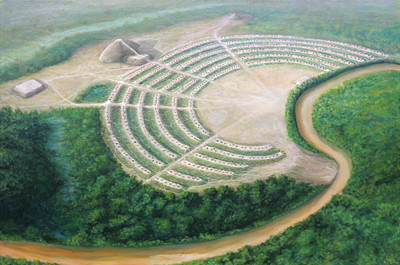
Small communities of the Early and Middle Archaic periods developed into larger cities by the Late Archaic Period when sites such as Poverty Point, in modern-day Louisiana, were established. The Poverty Point site has given its name to the unknown people who constructed it – the Poverty Point Culture – and both derive from the name given by Phillip Guier to his 19th-century plantation. Guier farmed the land without recognizing that the “hills” of concentric half-circles were artificial earthworks created by Native Americans. No one else realized this either until 1953 when an aerial photograph clearly showed concentric earthworks built out facing a plateau.
Woodland Period
Mound building continued and developed during the Woodland Period (usually divided into Early, Middle, and Late periods), a term which is usually associated with the eastern and middle regions of North America but is equally applicable to the Southwest and Great Plains in that similar advances were made across the continent. Ceramics became more refined as did craftwork generally as evidenced by statuary, tools, and weapons. In the Southwest, nations like the Hohokam built cities and designed efficient irrigation systems. In Alaska, the Inuit developed stone lamps, large fishhooks, better knives, and harpoons. Toward the east, individual nations built mounds not only as sacred places but for burial and residential purposes, and each different group engaged in long-distance and local trade.
One of the most significant developments was in the area of religion as evidenced by artifacts found at various sites. Poverty Point clearly shows a high level of some kind of religious activity early on but religion was only one aspect of that site as it was also residential. Some sites of the Woodland Period, such as Pinson Mounds in modern-day Tennessee, were built and used entirely for religious purposes. The Pinson site includes 17 large mounds and artifacts discovered there clearly indicate it was never residential but served a sacred purpose.
The Native Americans observed the religious belief of animism – the conviction that all things in nature are animated by a spirit and all are interconnected – and so recognized that the unseen world was just as real and powerful as the one they walked through in their daily lives. Taylor comments:
Natives believed that humans lived inside, rather than apart from, that web of the natural and supernatural. They conceived of their actions with all other-than-human beings as essentially social, as involving creatures more like than unlike themselves. Indeed, in their myths and dreams, people and the other-than-human could metamorphose into one another. As in all aspects of native life, the fundamental principle in harvesting nature was the pursuit of reciprocity. People felt justified in claiming a share in the other life around them but felt obligated to reciprocate by paying ritual honor and by minimizing waste. (19)
This reciprocity took the form of personal and communal gestures of gratitude for the life of an animal taken or a tree cut down for lumber, but sacred sites like Pinson Mounds were another expression of this same sentiment. Mound building in general, it is thought, was a response to the unseen world in that the forces of nature could be focused and, perhaps, controlled by centering them in a mound that raised the celebrants toward the heavens but kept them firmly connected to the earth. As mounds were often also raised by water, it is thought that all four elements of earth, air, fire, and water were celebrated and given thanks during mound rituals.
Mississippian Culture
The Mississippian Culture is so-called because the people primarily lived in the Mississippi River Valley, but they also established cities and villages in the Ohio River Valley, Tennessee River Valley, and elsewhere ranging from the Northeast down to Louisiana and out toward Indiana. The Mississippian Culture’s best-known communities were the Adena Culture (c. 800 BCE-1 CE) and the Hopewell Culture (c. 100 BCE - 500 CE) who built numerous mounds and further developed trade, commerce, craftworks, and technology. The Adena built cone-shaped mounds while the Hopewell’s were more intricate, often in the shape of animals, but both served a religious function.
As with Poverty Point, the mounds of the Hopewell Culture can only be fully recognized and appreciated from above. How the people were able to create a work they themselves could not see is unknown. The skill of the Adena and Hopewell in their ceramics, artworks, and technology such as irrigation ditches is impressive as is their apparent talent in farming and abilities in trade. Scholar Yvonne Wakim Dennis comments on the perception of Native Americans as “noble savages” quietly wandering the land, writing:
Far from being the passive children of nature depicted in colonial reports…Indians practiced calculated and extensive resource management. Nor were the people of the Midwest simple nomads, but urbanized engineers, long-distance traders, and large-scale farmers. (135)
Another nation, considered distinct from both the Adena and Hopewell, built the city of Cahokia (in modern-day Illinois), the largest urban center in North America prior to the 18th century, which flourished between c. 650 - c. 1350 CE. Cahokia may have developed through an appeal by the priestly class to neighboring communities to come and participate in the construction of the city’s enormous ritualistic mound – known as Monks Mound today – as well as the other 119 mounds used for other purposes.
Cahokia was a grand city with a wide central plaza, shops, ball fields, a solar calendar, residences for the lower class and others for the elite, and long fields of corn and other crops. The Cahokians cultivation of corn is one of the aspects separating them from the earlier cultures which had not mastered this crop. Their corn cultivation was so successful it not only fed the people of the city but was used in local and long-distance trade.
Another large city, known today as Moundville (located in Alabama) engaged in long-distance trade and drew people for religious services between c. 1100 – c. 1450 CE. The original names of both Cahokia and Moundville are unknown. Cahokia is named for the tribe living nearby at the time the site was first noticed by Europeans in the 19th century and Moundville was given its fairly unimaginative name for the many mounds dotting the landscape by the Black Warrior River.

The Moundville people maintained a strictly stratified social hierarchy which they demonstrated through the architecture of the city. The wealthy lived in wooden homes on top of the mounds which all faced the central mound in the plaza below, while the lower classes lived in thatch huts on the other side of the plaza. At some point, the city seems to have become a religious center and place of pilgrimage as its population increased at the same time that artifacts suggest a greater frequency of religious rituals.
Conclusion
The Mississippian Culture was still flourishing, although Cahokia had been abandoned (most likely due to overpopulation) when the Spanish conquistador Hernando de Soto (l. c. 1500-1542) arrived in the region in 1541. De Soto’s small army came in search of gold they had been informed could be found in abundance and killed a number of natives they believed were hiding the vast treasure from them. The De Soto expedition also brought diseases the natives had no immunity to, which killed many more even after De Soto himself had died and his men had returned to the coast.
The Spanish continued to make forays into the south and southwest regions of North America while the French were establishing themselves in Canada and throughout the Midwest of the present-day United States down to Louisiana. The French, also, brought diseases that killed large numbers of natives just as the English would do when they started arriving.
The English first attempted colonization through the Roanoke Colony in 1585 and again in 1587, both of which failed, and then finally managed to succeed with the Jamestown Colony of Virginia in 1607, which also would have failed if not for the intervention and assistance given by the native tribes of the Powhatan Confederacy. The English also attempted colonization of New England in 1607 through the Popham Colony, which was also assisted at first by the natives, until it failed. New England was first successfully colonized by the English in 1620 with the establishment of Plymouth Colony – which also owed its survival to the Native Americans, this time by the tribes of the Wampanoag Confederacy – and other New England Colonies developed quickly afterwards.
As more Europeans arrived in the “land of opportunity”, they seized more and more native lands, pushing the original inhabitants further and further into the interior. The natives fought back in a series of wars from the Anglo-Powhatan Wars of 1610-1646 to King Philip's War (1675-1678) and many others up through the 18th century and into the 19th, but a lack of cohesion and unity on their part coupled with the seemingly unending supply of immigrants the English were able to send against them eventually led to their defeat. By the late 19th century, most Native Americans were confined to reservations and the immigrants, having stolen their lands through treaties that were never honored, then settled into their new home and named states, provinces, rivers, and parks after the people who had once owned everything.

